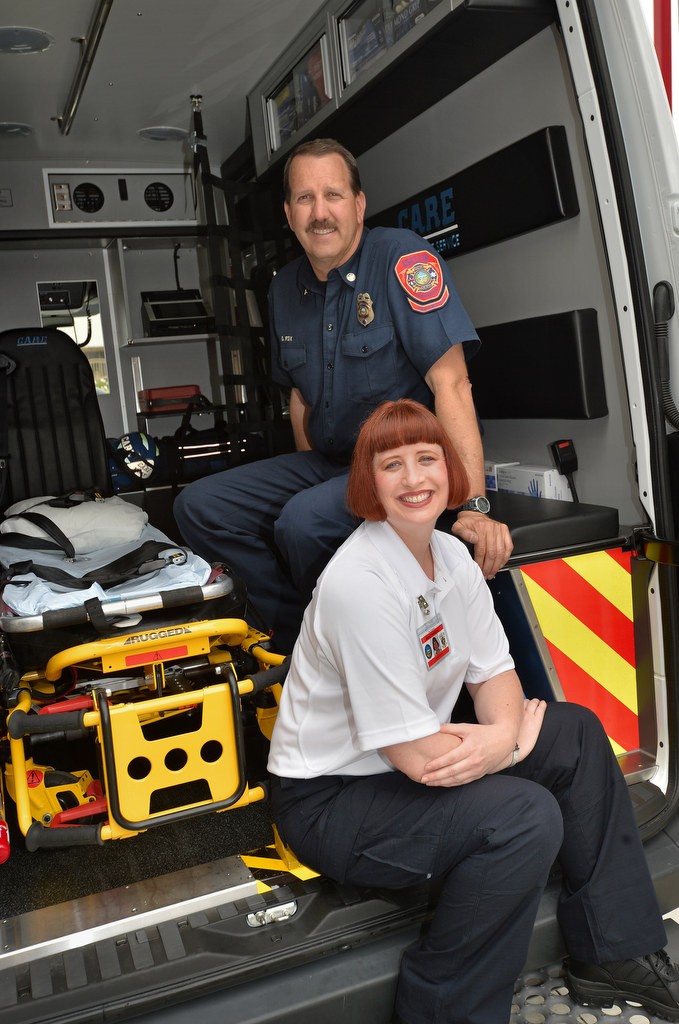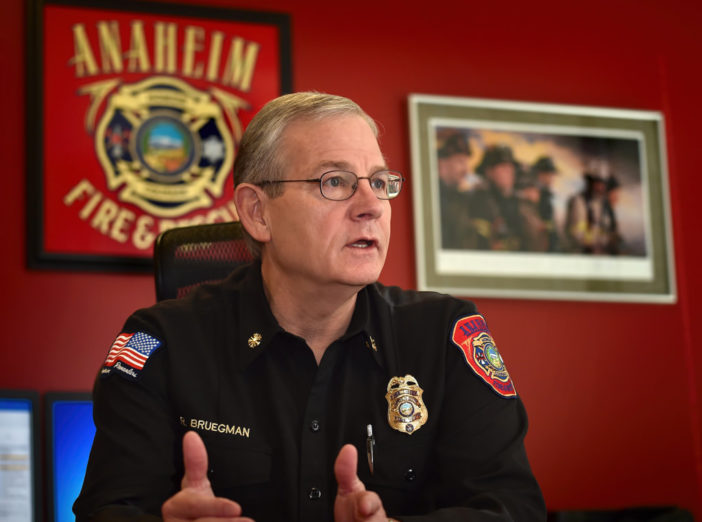Editor’s note: Behind the Badge OC sat down this week with Anaheim Fire & Rescue Chief Randy Bruegman for a brief chat on what’s happening at the agency. Below are excerpts from the interview.
What’s new with Anaheim Fire & Rescue?
Just last night (Tuesday, April 25), we took our 2017–2022 Strategic Plan and Standards of Cover document to the City Council, and it was adopted. It’s a five-year plan, but every two years we update it to keep us on track. It’s a playbook on how we run our organization.
There are eight strategic recommendations in the plan.
One is to maintain our agency accreditation (from the Commission on Fire Accreditation International, which is part of the nonprofit Center for Public Safety Excellence). Another is to maintain our Class 1 ISO rating. And there are several others that are very specific to how we deliver service to our customers.
One is the expansion of our Community Care Response Unit (CCRU, an ambulance equipped with a nurse and supplies that essentially transforms it into an urgent care center on wheels, allowing patients with non-life-threatening issues to be treated at home, resulting in cost savings to the overburdened health-care system).
There’s also a staffing plan, a capital plan, a plan to upgrade our 800-megahertz radio system, traffic signalization, community risk reduction programs, etc.
We’re really focused organizationally over the next two years to make sure we remain on track.
We look at it like we’re playing a football game, and we’ve got to have a good playbook if we want to do a good job.
The CCRU is a very innovative program. Are there any other innovative things in the works at AF&R?
We’re actually researching how we can use the mobile integrated healthcare process (CCRU) in different ways. We’re working with the Anaheim PD right now to see if there may be an application for a nurse practitioner to help them when an inmate gets sick so they don’t have to take the inmate to the hospital and tie up an officer for three to four hours in the ER
We’re also in discussions with a couple of hospitals about doing post-discharge follow up with critical patients. For example, if you go in and have a surgery and you’re a high-risk patient, oftentimes what we find on the emergency side is that in about two to three days after that discharge, we often get called back by that patient.
So our paramedics go out and assess the person and we end up always having to take him or her back to the hospital.
With a nurse practitioner, we maybe would be able to do a follow-up visit as a preventative measure so we’re not always just rotating these patients back into the emergency system.
We also recently were contacted by a group that runs a lot of care homes in the area to see if there’s some avenue that we can assist them on.

In this file photo, Capt. Scott Fox, a firefighter/paramedic with Anaheim Fire & Rescue, is shown with his partner, Nurse Practitioner Victoria Morrison, inside AF&R’s CCRU (Community Care Response Unit).
Photo by Steven Georges/Behind the Badge OC
One of the things our nurse practitioner (Victoria Morrison) has been able to do is really create a good network of services. Oftentimes, when we see the same patient over and over again in the field — which is fairly common — she’s often able to intervene in a way that she can stay longer with the patient and find out what their history is and align what their needs are with the services they need.
In a couple of cases, she’s actually been able to help people transition into assisted living.
We’re just trying to provide the best customer service while also lessening the impact on the emergency medical system.
What are some of the challenges facing Anaheim Fire & Rescue?
We’ve got a great opportunity in the city with the amount of growth that’s going on. It’s actually a little taxing on our staff, so I think one of our challenges is trying to be able to keep up with that growth.
When we had that significant downturn in the economy (starting in 2008), we had to take two units out of service, so we lost 24 firefighters. We’ve been able to get three of them back. But during that same period, our call volume went up about 40 percent. So we have fewer units now and our call volume is up. There’s a lot of new development that’s going to bring in not only more permanent residents, but also an influx of more people into the city. So the balance is trying to keep enough resources deployed to really meet the needs of the city.
Do you have a favorite firefighting story?
One significant event that resonates with me happened when I was a captain on an engine company in Colorado. There was a fire in a three-floor, center-hallway apartment building, and we were the first on the scene. There was heavy smoke coming out of all floors of the building.
When we rolled up, we saw a nice glow in the window on the third floor and figured that’s where the fire was. We took our (hoses) and went up the stairwell and down the hallway toward the apartment.
This was around Christmas time.
I was supposed to do a 360 (-degree check) on the building to have good situational awareness, but I didn’t do that that night. So we entered the apartment where we saw the glow and found a nice Menorah (a nine-branched candelabrum lit during the eight-day holiday of Hanukkah) in the window.
By the time we got back to the hallway to start back down, the fire already was blowing down the hallway. We were in a real bad situation.
Fortunately, a second engine company had arrived and had put a second (hose) in. The fire was actually at the top of the stairwell we had passed, and now it was blowing toward us.
That was pretty scary.
I always remember I’m supposed to be the person in charge making the good decisions, and that incident has stuck to me to this day.
I often reflect that the decisions we make on a day-to-day basis can have a long-term impact not only on ourselves, but on the people we are charged with leading. It’s a constant reminder that even today, situational awareness is very important.
Do you have any messages for the residents of Anaheim and the people who work in and visit the city?
We live in a different world today than we did 10 years ago, just from a homeland security standpoint. We know what our common risks here are in California, such as earthquakes and wildfires.
And I think that as a state, and especially in this area, we are in tune with that. I think for the most part, most people do think about their 72-hour emergency kits, and they have a game plan if they have to evacuate, and I think we’ve schooled them well over the last 20 to 25 years.
That doesn’t mean everyone is prepared, but I think our own situational awareness every day regarding what’s going in our community, and the threats that exist, is strong. As residents and citizens of this country, and as we travel around, we need to be aware of what’s going on around us. Don’t put yourself in any situation that makes you uncomfortable.
 Behind the Badge
Behind the Badge



